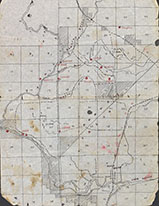Manuscripts Etc.
| CLOSE WINDOW |

|
The following items are drawn from the William Faulkner Foundation Collection at the University of Virginia's Albert and Shirley Small Special Collections Library (http://small.library.virginia.edu/). |
|
Both maps below were drawn by Faulkner. In the Faulkner Foundation collection, they are identified as "maps of Lafayette County, intended as frontispiece" for the 1939 novel The Wild Palms. As Thomas McHaney was the first to point out, however, they are two slightly different versions "of a small section of the Mississippi Delta" in Sharkey and Yazoo counties. McHaney assumes Faulkner did draw them during the writing of The Wild Palms, perhaps "in order to visualize the wanderings of the convict in 'Old Man,'" one of the novel's two narratives. Gabriele Gutting's explanation is much more persuasive. As she notes, these maps display the area around the Yazoo and Sharkey Rivers where Faulkner went hunting with others during deer season "for more than a decade, from November 1940 until the late 1950s." She notes how closely these maps follow the Mississippi state map of the Sunflower Wildlife Management Area, including the way Faulkner divides the region into those township quadrangles and uses cross-hatching to identify the areas that are privately owned, and so off-limits to hunters.   It's likely, then, that Faulkner created these maps of the real world with no particular fiction in mind, but for use on those annual hunting trips, to orient the hunters in the woods. But they are relevant to "Race at Morning," and revealing as reflections of the way Faulkner's imagination works. The presence on the maps of an "Oxford" (the real town in Lafayette on which Jefferson in Yoknapatawpha is based) is clearly what led to the library's misidentification. Gutting is undoubtedly right to suggest that all those red dots, named "Oxford," "Perkins," "Floyd," and so on, locate the camps of the various hunting parties that shared the wildlife area as a hunting ground - as the narrator's, the Hog Bayou and the Hollyknowe camps do in the story. "Oxford" would mark the spot where Faulkner's party camped. And the existence on the maps of a Hog Bayou and the town of Holly Bluff (which he renames Hollyknowe) suggests the extent to which Faulkner bases his tall tale of the chase after a fabulous buck on the real world he knew firsthand. So while these aren't maps of Lafayette, the relationship they allow us to see between a real place and a fictional setting reminds us of how intertwined the actual world and Faulkner's mythical Yoknapatawpha are. At the same time, these maps can give us a way to locate ourselves inside one of the great paradoxes of Faulkner's imagination. His art thrives on absence, ambiguity, indeterminacy. Who is Caddy Compson? or Joe Christmas? what happened at Sutpen's Hundred? But the way he brings this recognizably modern, potentially unknowable and meaningless world into existence is preoccupied with specifics. There are many moments in the manuscripts where he meticulously recalibrates a detail like "8 miles" to "five miles" to "three miles" – this is how far McEachern travels to church in Light in August, Chapter VII, in successive revisions – as if his invented world had to be correctly plotted on maps that would never be drawn of places that only exist in his art. The extraordinary level of detail on these two maps, down to numbering (and in several instances, re-numbering) each township quadrangle, not to mention the way he apparently redrew it to make it even more accurate, reminds us of how determined Faulkner is, artistically, to put as many details as possible "in [their] ordered place." SOURCES: Thomas McHaney, editor, The Wild Palms, volume II (Garland, 1986); Gabriele Gutting, "The Mysteries of the Map-Maker: Faulkner, If I Forget Thee, Jerusalem, and the Secret of a Map," The Faulkner Journal (Spring 1993), pp. 85-89. Citing this source:
|
